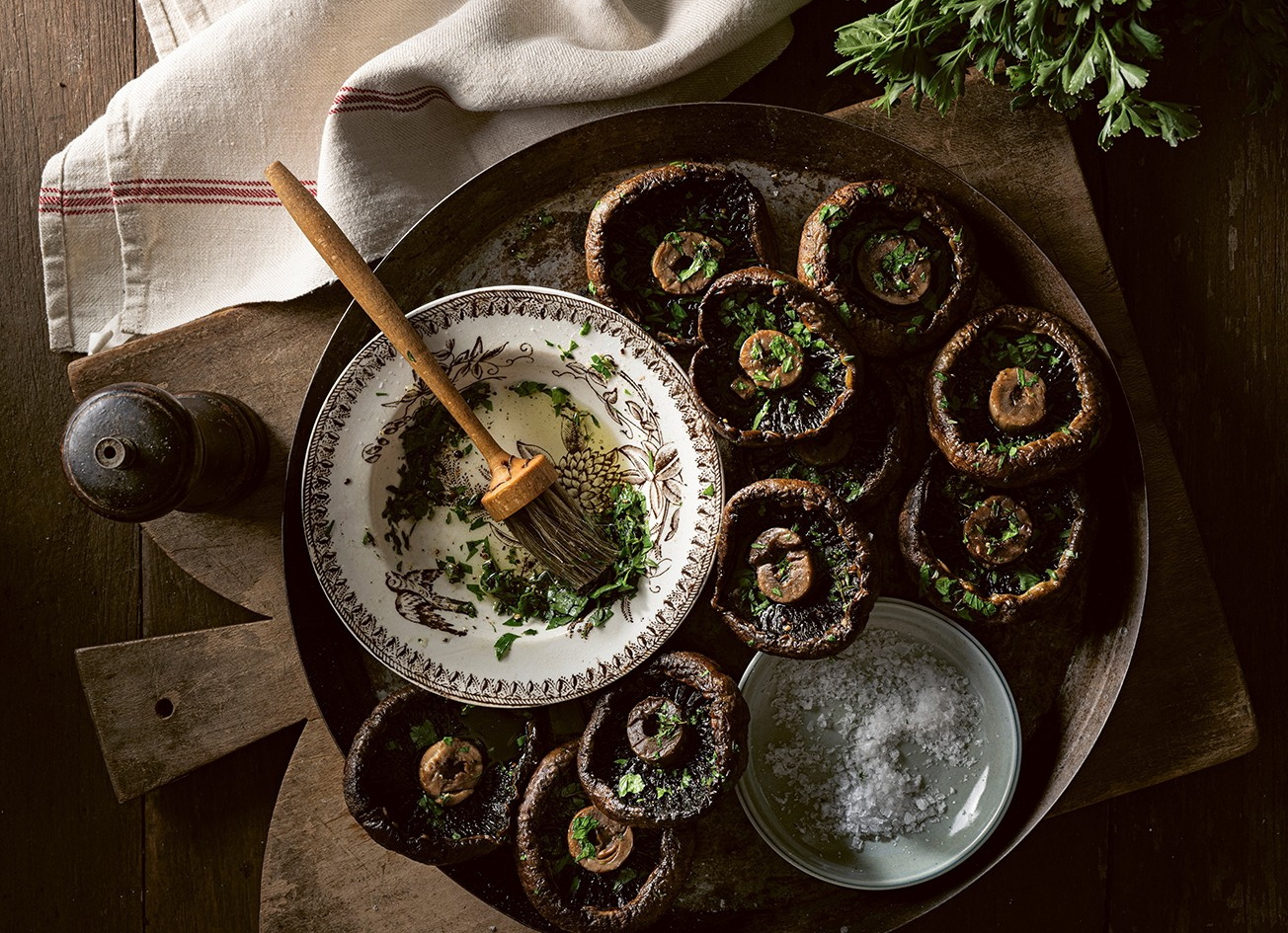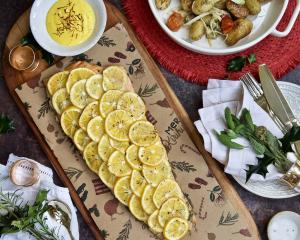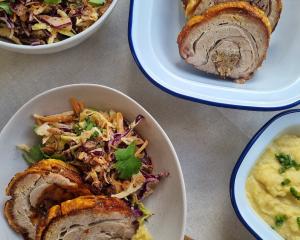
On a visit to New Zealand a few years ago, Barnes was taught how to make Kiwi chef Peter Gordon’s mother’s pavlova recipe on breakfast television.
‘‘Peter told me that if I followed his mum’s recipe to the letter, I could not go wrong. Many people told me over the years how hard it is to get a pavlova right, but I can assure you this recipe works a treat,’’ the musician says in their latest book, Seasons: Where the River Bends.

Their mushroom recipe is a great vegetarian or vegan option for guests on the big day or lovely side dish.
The couple have a large block of land near their Australian home in the Southern Highlands, which they have planted out in vegetable beds, an orchard and a rose garden.
‘‘Bathed in sunshine for most of the day, the vege garden now yields produce year-round, almost all of which we use in our cooking. That’s so satisfying.’’
He and Jane are helped in their garden by trusted friends, who know a lot more about gardening than they do, he says.
THE BOOK
Seasons Where the River Bends
By Jane and Jimmy Barnes
Published by HarperCollins
My mother’s Christmas ham
We all have our special dishes to make for the family Christmas feast. I’m usually in charge of turkey with peach and pine-nut stuffing, parsley, sage, rosemary and thyme. Sister Kaye does a colourful array of roast vegetables; being the artist she is, the platters are paintings with all the colours of the rainbow.
Sister Jep is the trifle specialist and everyone looks forward to that all-year long. EJ and young Jim prepare the salmon, Mahalia is on the greens and brother Richard is in charge of bread and cheese.
The other must-have, much-loved dish is Christmas ham. This was left up to our mum, who sadly left us a few years ago. We take turns to make this now, and not much has changed from her original recipe, which she used for 60 years.

SERVES: UP TO 20
8kg leg of ham
2 Tbsp Dijon mustard
¹⁄₃ cup brown sugar
2 x 450g cans pineapple rings in syrup, drained, syrup reserved
Whole cloves
20 cherries, halved and pitted
100g butter
Juice of 1 orange
¼ cup whisky (Glenmorangie)
1 Tbsp honey
1 Tbsp marmalade
Method
Heat the oven to 150°C (130°C fan-forced). Carefully ease the skin from the ham, leaving an even layer of fat over the meat.
Take the skin off the leg of the ham.
Rub the fat with a thin layer of Dijon mustard, then rub with half the sugar. Score the fat in a diamond pattern.
Use toothpicks to attach the pineapple rings all over the ham.
Push cloves in the spaces left between the rings. Use more toothpicks to attach a cherry in the centre of each pineapple ring.
Place ham in a large roasting pan.
Melt the butter and remaining sugar in a saucepan over medium-low heat. Add the pineapple syrup. Stir to dissolve the sugar, then slowly bring to the boil. Add the orange juice, whisky, honey and marmalade. Simmer for 10-15 minutes, stirring often to prevent it catching and burning, until reduced and thickened. Taste and add salt or sugar as you feel might be needed.
Drizzle half the glaze over the ham. Bake for 1 hour, basting with more glaze every now and then.
Increase the temperature to 160°C (140°C fan-forced). Bake for a further 30 minutes. Keep stirring around the leg and basting with the rest of the glaze, so that the ham does not dry out. The edges of the pineapple rings should be dark and caramelised but not burnt, or they will be bitter.
Transfer to a flat platter and decorate with a wide ribbon and branches of bay leaves around the bone. Pour the remaining glaze over the ham and add any remaining pineapple rings.

Timmy’s never-fail pavlova
Jimmy was taught to make this recipe by New Zealand chef Peter Gordon, who learned it from his mum [Timmy].
SERVES: 8
6 large egg whites
380g caster sugar
2 Tbsp cornflour
1 Tbsp malt vinegar
Whipped cream and seasonal fruit, to serve
Method
Heat the oven to 180°C (160°C fan-forced) and line a baking tray with baking paper.
Using a stand mixer with a whisk attachment (or hand-held electric beaters and a bowl), whisk the egg whites until almost stiff.
Reduce the beater speed to slow, and add half the sugar, 1 tablespoon at a time, beating until dissolved between each addition.
Once half the sugar has been mixed in, add the remainder in a slow stream, with the beaters still running. Continue to beat for 6-8 minutes, until all the sugar is incorporated and no longer grainy, and the meringue is glossy.
Sift the cornflour over the meringue and drizzle with the vinegar.
Gently fold together until combined.
Scoop the meringue on to a rectangular tray, roughly 20cm x 23cm, and spread so it is 3-4cm thick.
Place the tray on the centre rack in the oven and immediately reduce the temperature to 130°C (110°C fan-forced). Bake for 1 hour, then turn the oven off and leave the pavlova to cool for at least an hour in the oven.
Invert the pavlova and carefully peel the baking paper from the base. Transfer to a serving platter. Top with whipped cream and fruit.
Cook’s note:
We’re used to seeing pavlovas smothered in kiwifruit, strawberries or bananas, but Peter’s mum used a different ingredient: feijoa, a greenish, plum-like fruit that grows on a low shrub, originally in South America. A bit like a guava, it has a slightly sour taste that complements the sweetness of the meringue.
As luck would have it, we have those very shrubs growing in our garden. For years, we didn’t know what to do with them, but feijoa has since become a family favourite. Not only does it take pride of place on our pavlovas, but we also make a fig and feijoa jam with them.

Charcoal-grilled portobello mushroom steaks with herbs
We eat mushrooms every week, whether they’re enoki, shimeji, shiitake, oyster, Swiss or white button. They are highly nutritious and we just love them on their own, or in noodles, stir-fries, stews, pastas or pies.
The big portobello mushrooms are a special treat, especially when cooked on the hibachi grill, where they take on the smokiness of the charcoal and the flavours of the olive oil and herbs.
We often prepare these in place of a steak for vegan and vegetarian visitors.
SERVES: 4
8-10 medium portobello mushrooms
Sea salt and freshly ground black pepper
Extra virgin olive oil
Finely chopped flat-leaf parsley
Thyme leaves
Method
Heat a barbecue to medium-high. Use a vegetable brush to flick any dirt off the mushrooms. Gently pull off the stalks.
Cook the mushrooms top side down for 5-10 minutes, depending on their size and how soft you like them.
Turn the mushrooms over and season with salt and pepper.
Combine a good glug of olive oil with the herbs and brush over the mushrooms. Cook for another few minutes for the flavours to absorb.
Cook’s note:
This is great cooked on Jimmy’s hibachi grill, but is just as delicious done on any barbecue.











